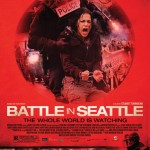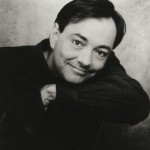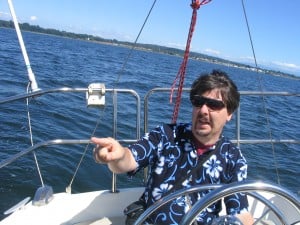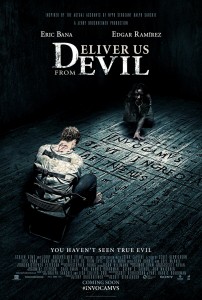 This year, I’ve seen two priests on the big screen. Both have marched solemnly toward a showdown with evil.
This year, I’ve seen two priests on the big screen. Both have marched solemnly toward a showdown with evil.
That evil takes two very different forms — a human being with a gun and a grudge, and a demon using a broken human being as his vessel.
Yes, these two films are altogether different experiences. But both deal cleverly, even subversively, with a variety of genre conventions (one’s a scenic, small-town, Masterpiece Mystery-type production; the other is a grim, big-city police procedural). Both present priests who are admirable men who can crumble if their weaknesses are exploited. Both are unusually sincere at heart. And both include far more interesting and complex depictions of faith than the preachy mediocrity that is typically categorized as a “Christian movie.”
I haven’t found the time yet to give an in-depth review of Calvary — the whodunit, or rather, the who’s-gonna-do-it — but here are some revealing responses from critics I regularly read.
Deliver Us From Evil — which arrives on home video just in time for Halloween — is a police procedural driven by the obsessions of my favorite current scare-master, Scott Derrickson. Tricked out with wild special effects, Deliver Us follows a cop who, skeptical about Satan, teams up with a Catholic priest in order to track a serial killer: a villain whose methods defy rational explanations, and who may not even be human.
Let’s take a closer look at that one. I saw Deliver Us From Evil last July, and I’ve been thinking about ever since.
•
For Steven Spielberg, it’s the slow zoom in a dramatic moment. For Martin Scorsese, it’s the long-take dolly shot. What’s horror-master Scott Derrickson’s signature shot? It may well become that hold-your-breath moment, as a terrified seeker’s face is illuminated in the very light that he’s shining into the darkness. That image builds suspense by concealing the very things we are straining to discern in the darkness. But there’s a sneakier implication: That the light may indeed be revealing part of the problem — the seeker himself.
It’s oversimplifying matters to say that, in Derrickson’s film, “the real problem is within.” But that idea has come up in his work before: In The Exorcism of Emily Rose, Laura Linney plays a skeptic whose doubt becomes a torment when the evidence suggests supernatural events; and in Sinister, Ethan Hawke plays a novelist searching for understanding about horrific crimes, only to discover that his neglect of family is like bait for the monster. These aren’t simple stories of good guys hunting bad guys. They’re about people who won’t overcome evil unless they discover the insufficiency of their power, the weakness in their faith.
In Deliver Us From Evil, Derrickon’s most ambitious project, Eric Bana plays Officer Sarchie, a cop with a weakness and a strength. His righteous anger can get the better of him (Bana has plenty of experience “Hulking out”). But he also has a sixth sense for, well, sinister activity — think Peter Parker whose “spider-sense” tingles when criminals are up to something.
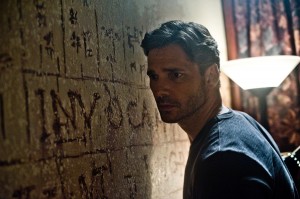 On this particular manhunt, the killer seems capable of things that Sarchie’s worldview cannot explain. (Sarchie the character — loosely based on the film’s inspiration, a real cop-turned-exorcist who wrote Deliver Us From Evil as a memoir, not a novel — is a lapsed Catholic, determined to explain away things that go “bump” in the basements of the terrified callers who ask for his help. But as this case leads him down into creepy cellars, his confidence dissolves in the glow of his own flashlight. Something wicked this way comes — has already arrived.
On this particular manhunt, the killer seems capable of things that Sarchie’s worldview cannot explain. (Sarchie the character — loosely based on the film’s inspiration, a real cop-turned-exorcist who wrote Deliver Us From Evil as a memoir, not a novel — is a lapsed Catholic, determined to explain away things that go “bump” in the basements of the terrified callers who ask for his help. But as this case leads him down into creepy cellars, his confidence dissolves in the glow of his own flashlight. Something wicked this way comes — has already arrived.
Bana’s leading-man status is the first of several remarkable things about Deliver Us From Evil. It’s been nine years since Spielberg’s Munich, where Bana played the Israeli avenger who learns that responding to evil with violence can hollow out a heart. It’s been ten years since he was cast as the conscience-burdened Greek hero Hector, dueling Brad Pitt’s Achilles in Troy. But his full commitment to this performance proves here that he’s still a fine choice to play a movie’s Muscular Conscience.
Sarchie he comes equipped with the genre accessories: an amusing sidekick (Joel McHale, all smirk); a beautiful — and thus vulnerable — wife (Olivia Munn); and a cute-as-a-button daughter who may as well wear a shirt that says “Hey Evil Spirits, Please Come Haunt My Bedroom” on the front, and “Hey, Villains — Keep Me In Mind For This Movie’s Final Act” on the back. What sets good genre-film directors apart from bad ones? It isn’t their avoidance of convention, but whether or not they find a way to suspend our disbelief and surprise us even when we know the formula. Great genre-film directors find ways to do something truly imaginative within those routines, or alter them in some powerful way.
Here, Derrickson does both. He keeps us leaning forward in hopes of naming and catching the killer, but he’s also pulling a bait-and-switch. It’s a police procedural cake pan, but he’s filling it with horror-genre cake batter. So the result isn’t much like anything we’ve seen before.
Derrickson, his co-writer Paul Harris Boardman, cinematographer Scott Kevan, and a chillingly effective team of sound designers, mix up the ingredients; his actors — Bana, McHale, Munn, and the extraordinarily charismatic and confident Edgar Ramirez doing his first big genre pic — sell the results. They’re better than the genre requires. But Derrickson’s secret weapon here is one we rarely see in horror: This film is “Inspired by Actual Events.” That’s a claim likely to set film critics to scoffing. Come on, really? Demon possession? Crosses? Chants? Holy water, and all that?
But look into it, folks — Ralph Sarchie is for real, and his on-the-record stories are unsettling.
You may not believe in this stuff, but much of the world does, and it’d be tough to write off as mere fiction the testimonies of exorcism that defy rational explanation, and the cultural traditions around the world that accept the existence of demons. The Italian family whose haunted home is investigated by Sarchie — that’s not make believe. In an online discussion, Derrickson said, “I saw the video recordings that the real Ralph Sarchie made with the family members that the scene was based on. Those people weren’t lying, weren’t trying to get attention, and were absolutely terrified of their own house. Chilling to watch.”
I’m of the opinion that this stuff goes on scaring us because there is some truth to it. Whether we’re watching a B-movie like Paranormal Activity or an art film like No Country for Old Men, we are troubled because there is something about the suggestion that Other Powers are at work in the world… something that we sense to be true, even if it slips past the use of scientific instruments. And the fact that such testimonies persist — across generations, cultures, and geographic boundaries, while maintaining the same basic details — should give anybody pause before shrugging the spookiness off as “psychological disturbance” or coincidence. “There are more things in heaven and earth, Horatio, than are dreamt of in your philosophy,” Shakespeare’s Hamlet insists, and I believe that. But some religious traditions endure because they have given us a vocabulary about such things that rings true.
Sarchie — the character, not the real guy — wants to shrug off the suggestion of demonic powers, but the deeper he descends into some overlapping mysteries, the more he sees things that he wishes he could un-see. This isn’t an idiot-factor horror movie, in which stupid people get what’s coming to them, or a monster lurks just waiting for somebody to stumble into his clutches. Derrickson already fulfilled that formula with Sinister — masterfully, in my opinion. Here, he’s aiming higher. He wants to bring a stereotypical American hero — a muscular cop, a family man, and a pretty rational guy — face to face with the devil, or pretty close. He wants to show us that our heroes aren’t strong enough (or smart enough) to take on the real enemy, not without expanding their worldview and learning where the real power to overcome evil comes from. It’s Obi-Wan Kenobi arguing with Han Solo about the Force all over again. Sarchie insists that he’s seen “nothing that can’t be explained by human nature.” Mendoza replies, “Then you haven’t seen true evil.”
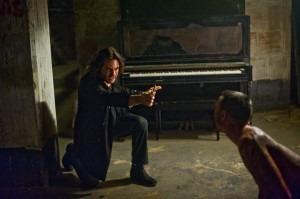 Thus, Sarchie’s a skeptical Scully to the enlightened Mulder of Father Mendoza, a “plainclothes priest” who specializes in demonology and exorcism. Mendoza believes. He’s seen enough to know, and his faith fills in the rest. Sarchie’s seen enough to know too, but he actively resists the faith that would complete the picture — he knows that he cannot embrace the truth without it costing him, without it changing his head, his heart, and his choices.
Thus, Sarchie’s a skeptical Scully to the enlightened Mulder of Father Mendoza, a “plainclothes priest” who specializes in demonology and exorcism. Mendoza believes. He’s seen enough to know, and his faith fills in the rest. Sarchie’s seen enough to know too, but he actively resists the faith that would complete the picture — he knows that he cannot embrace the truth without it costing him, without it changing his head, his heart, and his choices.
As Sheriff Bell said in No Country for Old Men: “The crime you see now, it’s hard to even take its measure. It’s not that I’m afraid of it. I always knew you had to be willing to die to even do this job. But, I don’t want to push my chips forward and go out and meet something I don’t understand. A man would have to put his soul at hazard.”
Just as Mendoza is, for this moviegoer, the film’s strongest character, so Édgar Ramirez is the actor who steals the show. He’s quiet, simmering, and introverted, which makes audiences lean forward. And he’s given a rich backstory — in part because Ramirez thought the character in the original screenplay needed work, so he inspired a rewrite by doing his own research on a Jesuit priest from Latin America.
As Sarchie, Bana is earnest and aggressive, seemingly the kind of cop hero that audiences love — which makes it all the more interesting that he never really takes control of the narrative, but remains a cipher, a guide whose doubts most people will understand.
That’s Derrickson’s twist: As in Raiders of the Lost Ark, the hero’s job is to realize that he’s not going to be the hero this time around. He cannot win this battle. His job is to (forgive me) “let go and let God.” Prayers are not magic spells but appeals for someone else to engage, to fight in our place. Best to invite the Almighty into the confrontation.
And how does God fight? By presenting himself as love, willing to suffer any evil we throw at him, willing to die for us. He shows us that true deliverance lies not in returning evil for evil, violence with violence, cruelty with cruelty, but in overcoming evil with good (see footnote*).
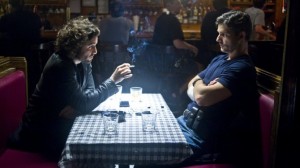 Thus, when these two — the man of faith and the man of skepticism — sit down like Pacino and De Niro in Michael Mann’s Heat, we feel that we’ve finally arrived at the film’s reason for being. It’s too bad, then, that this scene flies by, and that their conversation barely scratches the surface of their subject.
Thus, when these two — the man of faith and the man of skepticism — sit down like Pacino and De Niro in Michael Mann’s Heat, we feel that we’ve finally arrived at the film’s reason for being. It’s too bad, then, that this scene flies by, and that their conversation barely scratches the surface of their subject.
Similarly, while Bana and Munn make a good-looking couple, the scenes between them were too slight to make me really feel the tension when the inevitable tests come.
Still, as Sarchie and Mendoza close in on the responsible party, Derrickson keeps things strange by keeping them true — drawing on the details of eyewitness accounts and recordings of exorcisms. Yeah, the big showdown with demons will come, which makes for sensational big screen spectacle; but Derrickson makes sure that nobody leaves the theatre feeling completely satisfied. Demons don’t get locked away like crooks, and you can’t shoot them. The movie provides steps forward for its characters, and this particular demon hunt reaches a blistering, explosive conclusion. But moviegoers will feel that they’ve just seen an origin story — an episode in which a cop finds new vision and confidence, and a partnership worth following is formed.
Would it be too much to ask for a sequel? The devils, they’re still out there. And Mendoza has so much more to teach Sarchie.
Did you “like” the movie? Your answer will have a lot to do with what you believe. If you believe that “possession” is something different than a psychological disorder, this film may have the ring of truth. But if you think science can explain every mystery we encounter, and that spiritual warfare is just some dark-age delusion, this won’t feel like much more than a trip through a hokey house of horrors.
Me, I don’t think questions about spiritual forces get enough airtime at the movies. As someone who has come a little too close for comfort to a couple of circumstances like this, and who has close friends who express regret that they ever encountered such stuff first-hand, I don’t attend to stories like this the way I attend to, say, superhero movies. What Derrickson’s spotlighting is not just a bunch of “genre cliches.” Most of the time, entertainers treat demons as merely mythological, exploiting them for cheap thrills. Derrickson has enough respect for common, consistent testimonies — and enough faith in humankind’s ongoing experience of mystery — to take things much more seriously. By adhering to the details of actual testimonies, he provokes audiences to wrestle with the implications of those testimonies… that certain horrors cannot be just labeled and shelved as mental conditions or temporary psychosis.
This is, in some senses, a genre film, and thus certain familiar tropes are in play. But it’s a formula movie well-played, and one that layers formula upon formula into an intriguing hybrid. It’s built to entertain. But this is also a Scott Derrickson film. It’s going to give you more than you bargained for. It might keep you up at night with troubling questions about evil committed by humankind and, yes, evils done by something else. Derrickson shouldn’t have been able to “deliver” something that works both as a late-Friday-night popcorn scare fest and as a provocation to ask ourselves what we make of the prevalence of testimonies — across generations and cultures — regarding spiritual warfare of this nature. But that’s what he did.
No, not everything works. Olivia Munn should’ve been given something more than the usual concerned-mom/”What about us?” cop’s wife, because she made an impression with what little she had to do. I didn’t get enough from McHale’s character for his big scene to pack the necessary punch. And the end-credits montage, going to extremes to disturb and distress, ends up merely trying our patience. This material called for something a little more subtle and, dare I say it? Sacred.
But the cast is strong, the sound design is fantastic, and everything looks great. As the craft of horror goes, it’s a scream; and as a game of “Catch the Homage” or Use Your Allusions,” it’s a hoot and a half. (Blade Runner fans — watch for the clever Roy Batty reference at the end.)
And for the record, Mr. Derrickson, sir, if you’re listening: I would follow a whole franchise of Édgar Ramírez as The Specialist.
•
* This is a bit of a tangent, but it’s one I find compelling, so bear with me. The climactic confrontation in Deliver Us From Evil is profoundly Christian because it becomes a clash not of one violent force against another, but a meeting of the enemy’s violence with God’s willingness to suffer for the sake of love.
Many Christians get very excited about the idea of “The Battle of Armageddon,” a sort of epic-fantasy battle in which the armies of God and the armies of Satan clash at the end of the world. But what’s remarkable about the Scriptures upon which such fantasies are based is this: Revelation describes the enemies of God gathering at a place called Megiddo. But the battle never actually occurs. All that happens is this: God says from heaven, “It is done,” an echo of what Jesus said on the cross when he overcame by entering into death and overcoming its power. When those words are spoken, that is that. All resistance to God implodes, for the Great Liars have their strongest weapon — death — proven to be powerless against God’s immeasurable love. Thus, apocalyptic stories that show the Powers of Good overcoming Evil with a sort of coercive violence miss the whole point. It is God’s willingness to accept ultimate the ultimate suffering of our hatred, rejection, and violence — as an expression of his immeasurable love for us — that is (and has always been) the invincible, overcoming force in the universe. It is finished, indeed.
•
BONUS: Here’s Scott Derrickson giving nothing short of an epic interview to Steven Greydanus.
•

